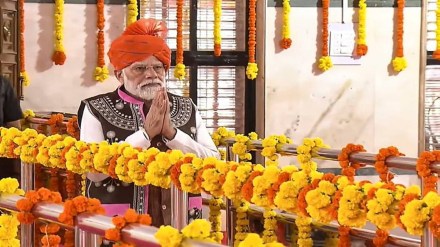Prime Minister Narendra Modi will visit Ayodhya on Tuesday to ceremonially hoist a saffron flag on the spire of the Ram temple, symbolising the completion of its construction. Ahead of the prime minister’s visit, Chief Minister Yogi Adityanath reviewed the preparations here and issued necessary directions to the concerned officials.
The right-angled triangular flag, measuring 10 feet in height and 20 feet in length, bears the image of a radiant Sun symbolising the brilliance and valour of Lord Rama, with an ‘Om’ inscribed on it along with the image of Kovidara tree, a statement issued by the prime minister’s office (PMO) said.
What did PMO say?
The sacred saffron flag will convey a message of dignity, unity, and cultural continuity, embodying the ideals of Ram Rajya, the PMO said. The flag will rise atop a ‘shikhar’ constructed in the traditional north Indian Nagara architectural style, while the surrounding 800-metre Parkota, a circumambulatory enclosure built around the temple designed in the south Indian architectural tradition, will showcase the temple’s diverse architecture, it said.
During his stay in Ayodhya, the prime minister will visit the Saptmandir, which houses temples related to Maharshi Vashishtha, Maharshi Vishwamitra, Maharshi Agastya, Maharshi Valmiki, Devi Ahilya, Nishadraj Guha and Mata Shabari. This will be followed by a visit to the Sheshavtar Mandir. Modi will also visit the Mata Annapurna temple and perform ‘darshan’ and ‘pooja’ at the Ram Darbar Garbh Grah, which will be followed by ‘darshan’ at the Ram Lalla Garbh Grah, the statement said.
Timing of the flag hoisting
At around noon, Prime Minister Modi will ceremonially hoist the saffron flag on the ‘shikhar’ of the Ram Mandir, symbolising the completion of the temple’s construction and ushering in a new chapter of cultural celebration and national unity, the PMO statement said.The prime minister will also address a gathering on the occasion.“The programme will take place on the auspicious Panchami date of the Shukla Paksha in the month of Margashirsha, coinciding with the Abhijit Muhurat of Shri Ram and Maa Sita’s Vivah Panchami, a day symbolising divine union,” the statement said.
The date also marks the martyrdom day of Guru Tegh Bahadur, the ninth Sikh Guru, who meditated in Ayodhya for 48 hours in the 17th century, further enhancing the spiritual significance of the day, it said.The temple complex features 87 intricately carved stone episodes from the life of Lord Ram based on the Valmiki Ramayana on the outer walls of the main shrine, with 79 bronze-cast episodes from Indian culture placed along the enclosure walls.
Together, these elements provide a meaningful and educational experience to all visitors, offering deep insight into Lord Ram’s life and the cultural heritage of India, the statement said. On the eve of Modi’s visit, Adityanath on Monday conducted an on-site review to ensure seamless planning and arrangements, and passed necessary directions to the concerned officials, a statement issued by the Uttar Pradesh government said.
A total of 6,970 security personnel, including commandos from the ATS, NSG snipers, cyber experts, and technical teams have been deployed in the holy city as part of heightened security measures, it said. Anti-drone technology and advanced monitoring systems are also operational on the temple premises and surrounding areas.
Senior officials, from superintendents of police to field-level teams, are overseeing the operations to ensure seamless coordination, the statement said. Personnel tasked with crowd management, security screening, explosives detection, and emergency response have been stationed across key locations. Special units, including bomb squads, dog squads, VVIP protection teams, fire units, and rapid response teams, are active in the city, the statement said.
